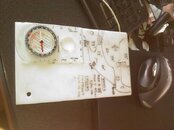- Messages
- 20,561
- Reaction score
- 14,946
- # of dives
- I'm a Fish!
a much better solution to all of this nonsense that would make you much happier is the following. Basic, cheap standard land based compass, super glue to a piece of plexiglass that has been sanded down to be able to write on. Small piece of bungee looped over at the top to hold a golf pencil, and the hole at the bottom would normally have a bolt snap zip tied in to clip off. This makes an infinitely more accurate navigation tool than the wrist or retractor mount compasses, and also acts as your normal dive slate. The map drawn on there below is of Fantasy Lake Scuba Park in NC and is what is used by the NCSU scuba program, so that way you have your map up top, compass right below. Int he open space you can write all of your dive limits for depth/time/pressure, and below that write all of your waypoints if you are practicing navigation. On the back side you have a pretty good sized slate to write whatever you want. The bolt snap gets held by the right hand to allow free access to the inflator, and the left side of the slate bisects the diver so you are going in a straight line instead of crabbing sideways. Whole setup for less than $20 with half of that going to the bolt snap, other half to the compass. Best spot to clip this is the back D-ring on a crotch strap, but hip D-rings work fine as well.
Do standard brass/glass SPG on a shorter hose, and if you want to hang onto an analog depth gauge which I do for open water diving when I don't have a spare computer with me is to just throw it in a pocket of some sort. Either waist or thigh.

Do standard brass/glass SPG on a shorter hose, and if you want to hang onto an analog depth gauge which I do for open water diving when I don't have a spare computer with me is to just throw it in a pocket of some sort. Either waist or thigh.





